Are you ready to learn to play in the second position on your violin?
The first, third, and sometimes fifth positions are usually the ones taught first. The even-numbered positions have the stigma of being difficult, maybe partly because they are taught in that order: if you’re learning second after third (or even worse, the fifth position), it must be more difficult, right?
That is partially true – second position does have some difficulties but there are ways to learn it and it can be very easy. Also, it can be a powerful tool for orchestral repertoire and playing concertos!
I hope this article will help you learn the second position the easiest way!
What Notes Are in the Second Position?
The second position is located between the first and the third position. If you have practiced the first position, note that you have to place your first finger where you would normally place the second finger:
- On the G string: Bb, B, C, C#/Db, D, D#/Eb, E
- On the D string: F, F#, G, G#/Ab, A, A#/Bb, B
- On the A string: C, C#/Db, D, D#/Eb, E, F, F#/Gb
- On the E string: G, G#/Ab, A, A#/Bb, B, C, C#/Db
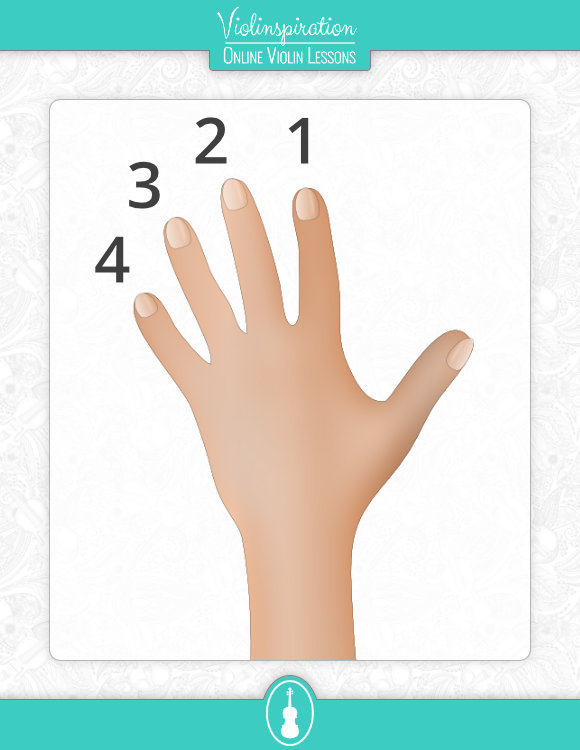
Second position fingering cheat sheet:
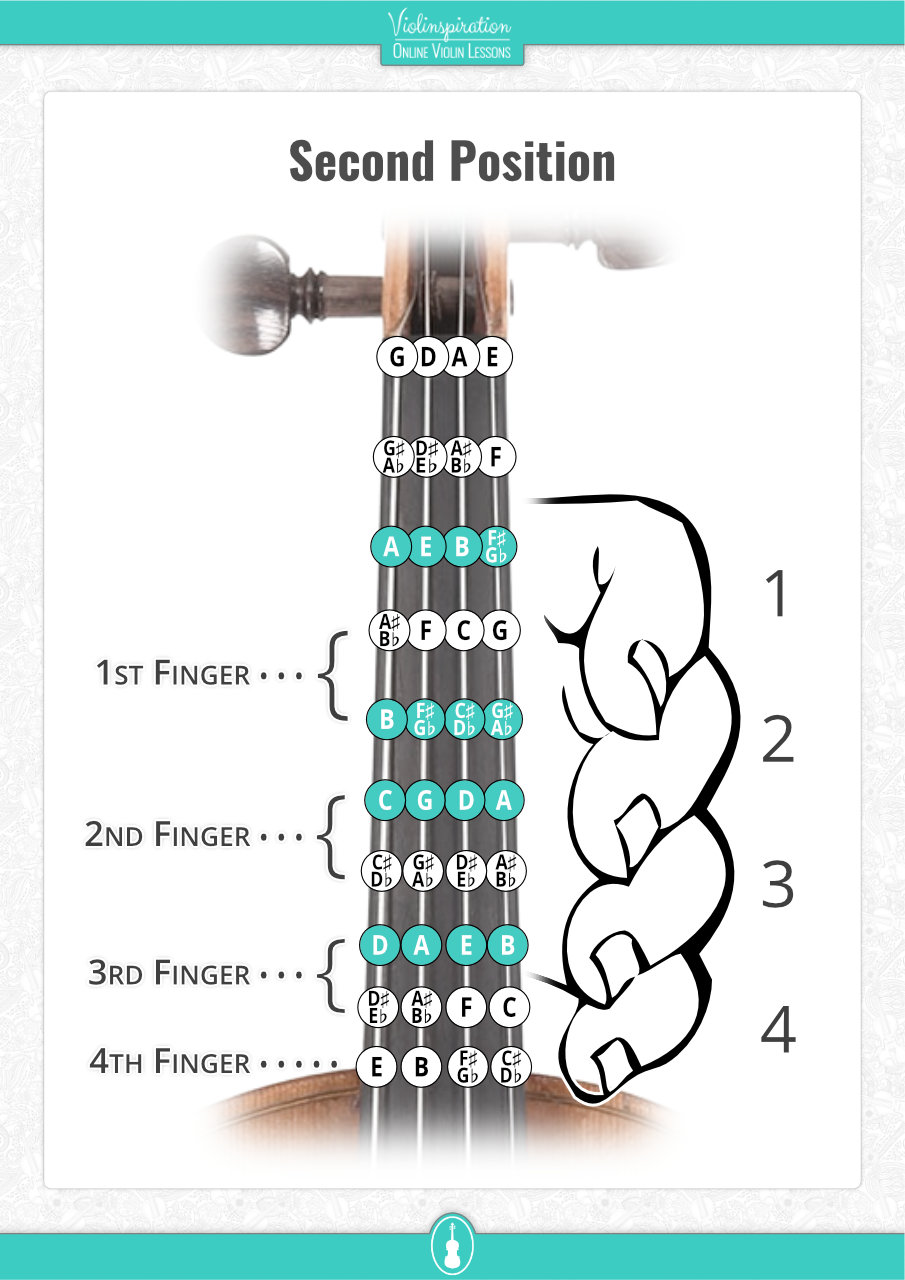
What Are the Benefits of Learning the Second Position on the Violin?
- You’ll have a new position in your skillset.
- It fills the gap between the first and third position.
- Several scales are more comfortable to play, such as C, C#, Bb, B, F, and F#. That covers both major and minor scales. And yes, that means that the easiest scale, that being C major, is more comfortable in the second position.
- A lot of orchestral repertoire and concertos will become much easier to play.
- Going from the first position to the second is much easier than from the first to the third position because it is a smaller shift.
Shifting From First to Second Position
In relation to the first position, the second position is a semitone or a tone higher. That means it lacks one note from the first position but has one more note you’d otherwise get from the third position. It makes a perfect middle ground that you’re going to need in particular if a song or composition is in one of the above-mentioned scales.
Because it’s that close to the first position, shifting becomes easier. It can help if you think of the second position as supplementary to the first.
In order to shift to the second position, play a note with your first finger in the first position, then play a note with the second finger. Next, go back and play the first note again and shift to the second position so your first finger is playing the note previously played by your second finger from the first position. Try this exercise on all strings:
- Press your finger on the G string playing A, then press your second finger to play Bb. Go back to A and shift to the second position, playing Bb with your first finger.
- Press your finger on the D string playing E, then press your second finger to play F. Go back to E and shift to the second position, playing F with your first finger.
- Press your finger on the A string playing B then press your second finger to play C. Go back to B and shift to the second position, playing C with your first finger.
- Press your finger on the E string playing F#, then press your second finger to play G. Go back to F# and shift to the second position, playing G with your first finger.
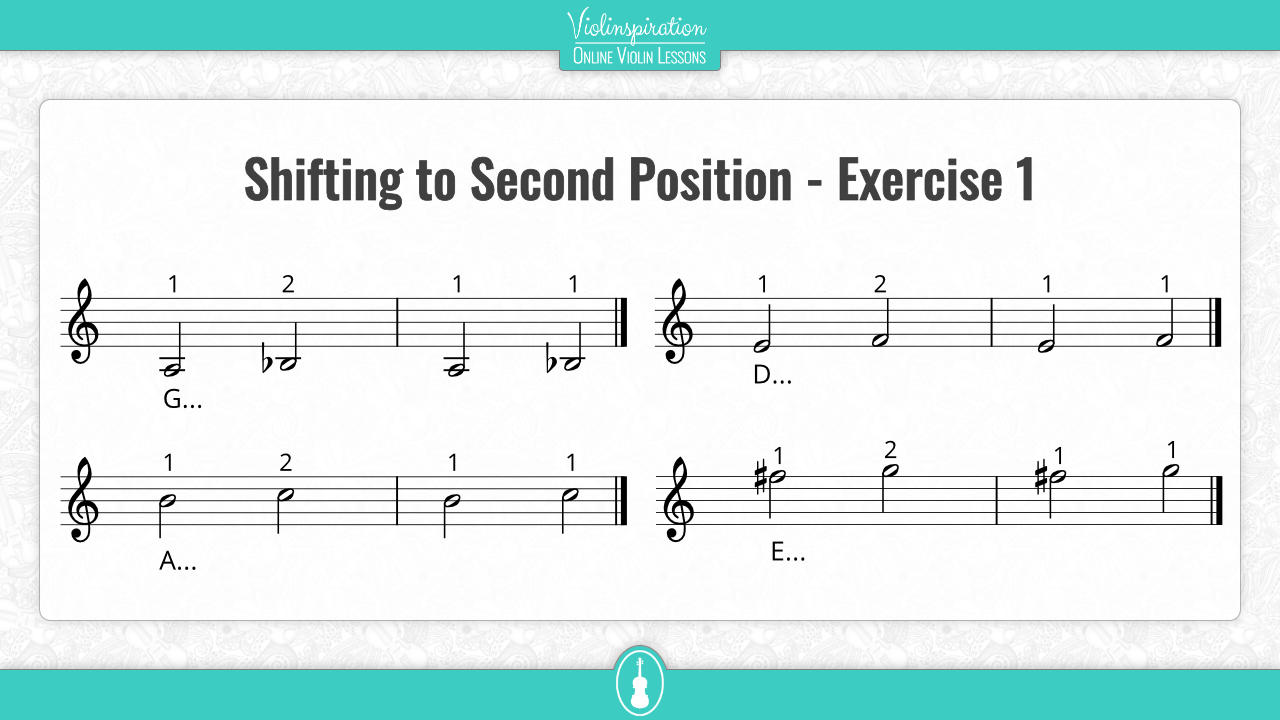
Of course, don’t hesitate to try all combinations with sharps and flats, especially with the second finger. That means try both Bb and B on the G string, F and F# on the D string, C and C# on the A string, and G and G# on the E string.
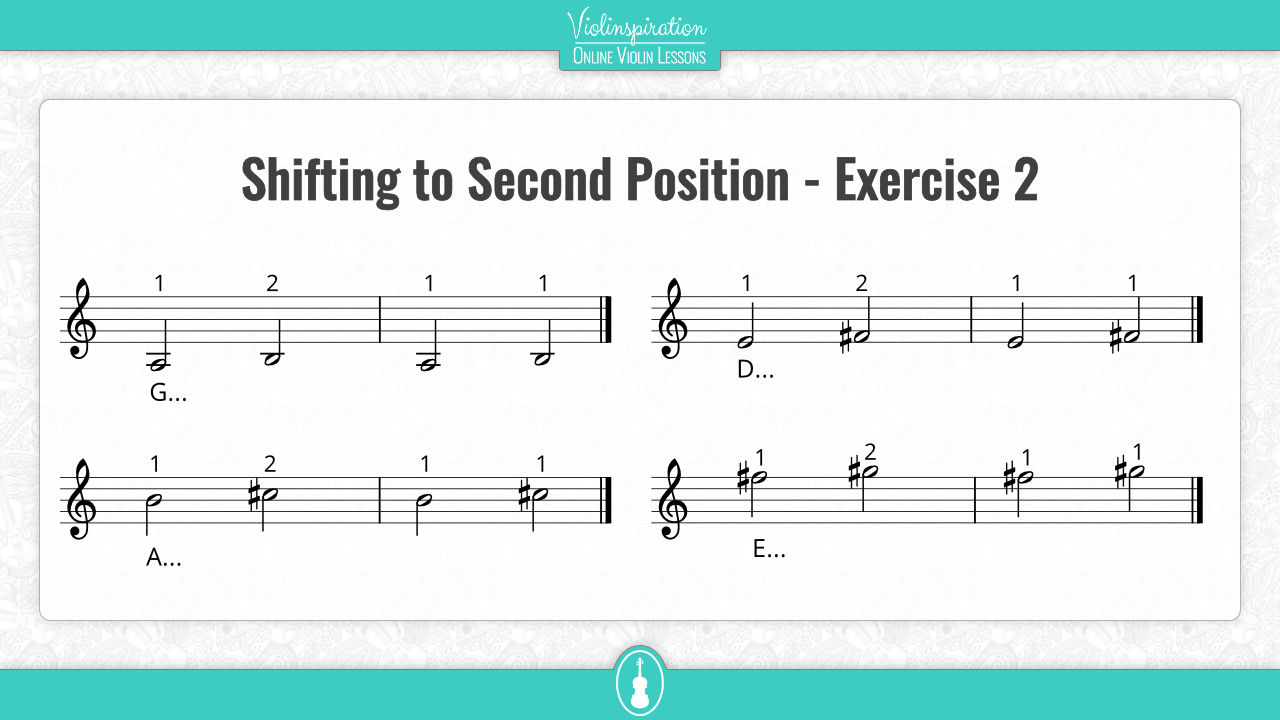
For extra difficulty try the accidentals with the first finger too!
What is important to remember is that you always change position with the first finger. You should put the first finger in its position before placing any other finger.
How Do You Play in the Second Position on the Violin?
Playing in the second position on the violin is similar to playing in the first position: the first finger goes on the spot where the second finger was in the first position. The thumb and base of the index finger hold the violin’s neck. The palm of your hand should not touch the body of the violin.
When learning to play in the second position, make sure to pay attention to the following aspects:
1. Left-hand thumb and index finger position
If you have practiced the first and third positions, changing from first to second position will seem easy. Contrary to the first position where your palm is near the peg box, or the third position where it’s near the violin’s body, in the second position your palm at first might feel like it “dangles.” Of course, it doesn’t since your thumb and the base of your index finger still touch the violin, but because of that, a common mistake is to leave the thumb behind when shifting from first to second. Look out for that and avoid it, as it will make playing difficult.
2. Spacing between fingers
The space between each finger is practically not reduced, as it is in higher positions, because it’s so close to the first position. Though some adjustments must be done, finding the correct intervals won’t be too hard.
3. Fingering in the sheet music
One of the most difficult parts for anyone trying the second position for the first time is the different fingering. Because there are no common fingers (like the fifth position) and it’s just one digit apart from either the first or third position, for the most part, it creates some confusion. This confusion might be rooted in the fact that in the second position, the notes assigned to odd-numbered fingers in the other two positions are now on even-numbered fingers, and vice versa.
To avoid this confusion, you might want to start exploring this new position right after the first – in essence, learn them in order.
The second position will help you greatly whenever there is a passage in which you would either need to go to the third position or change strings just to play one note just above the last one. That happens quite often in music. It is advised to not change strings if you can, so there won’t be any noise but also for smoother bow movement. That’s why violin positions are useful, so mastering the second position will be an asset, especially in high tempos.
How Do You Practice the Second Position on the Violin?
You should practice the second position on the violin by learning to shift, playing scales, arpeggios, and technique exercises. During all these exercises, you should pay attention to practicing slowly and maintaining the proper intonation.
First, I recommend you doing several preliminary exercises to memorize the notes in the new position.
A good example of this is the exercise given above to find the position. Next, you can try shifting exercises with all fingers and accidentals combinations:
Exercise 1
Play B, C, and D on the A string. Then go back to B, and shift and place your second finger playing D.
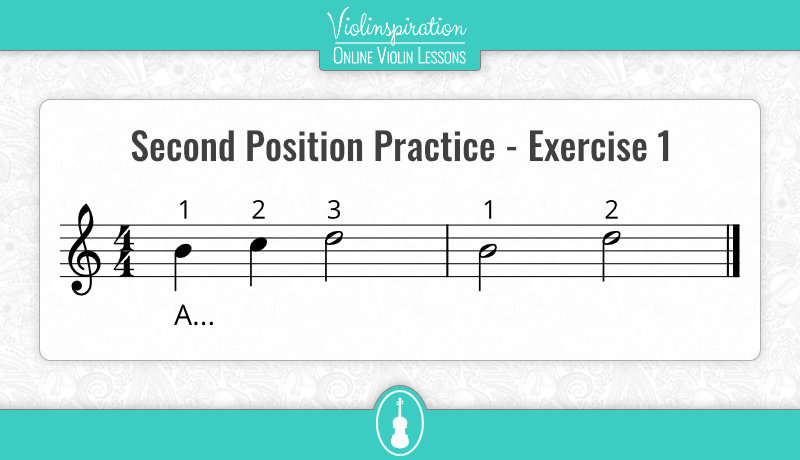
Exercise 2
Another exercise will be to shift and press a different finger to the first. Again, you’re on the A string. Play B and C, then shift directly to D with your second finger. Of course, the first finger will follow behind and is the one orchestrating the change in position.

Exercise 3
A bit of a more advanced exercise is to shift and then play with the other fingers: staying with our example of starting on the A string, play B, then C in the second position, and then D.
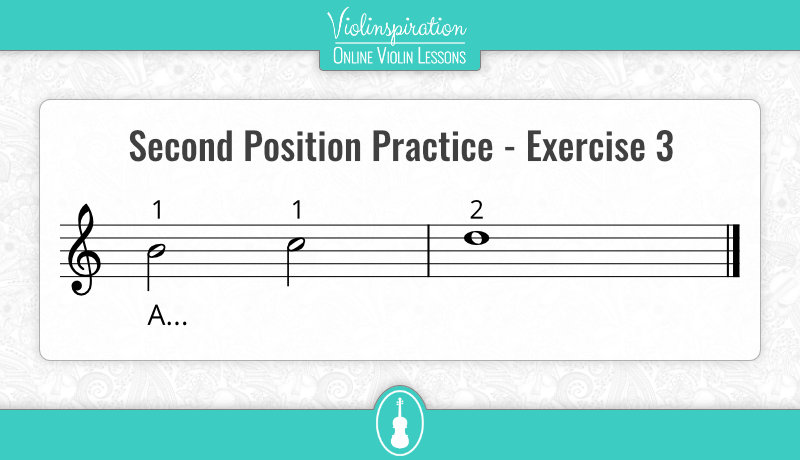
Exercise 4
An even more difficult exercise is to shift back from the third position to the second. This is a very rare situation that you will hardly ever use, but practicing means that you’re trying extreme situations, so as to be more than ready for the more mundane ones! Find D on the A string in the third position. Go back to the first position playing C and D. Then go back to the third position playing D, and shift to the second position playing C and D.
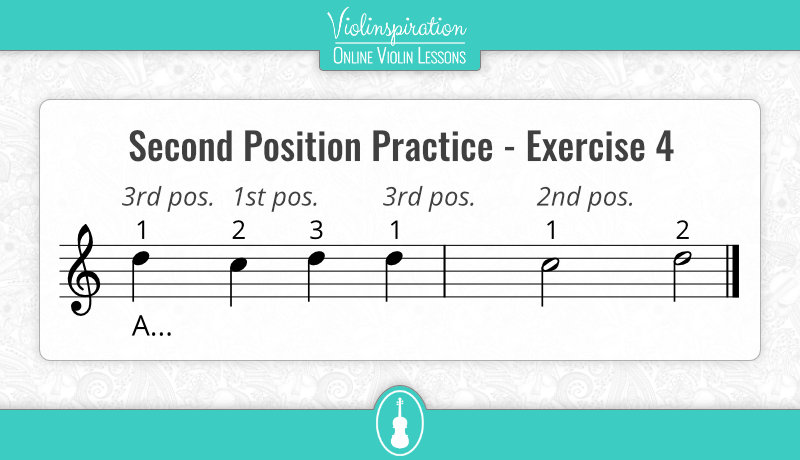
After that, you can combine the three positions by going from playing D in the third position to B and C in the first position, and then D in the second position.
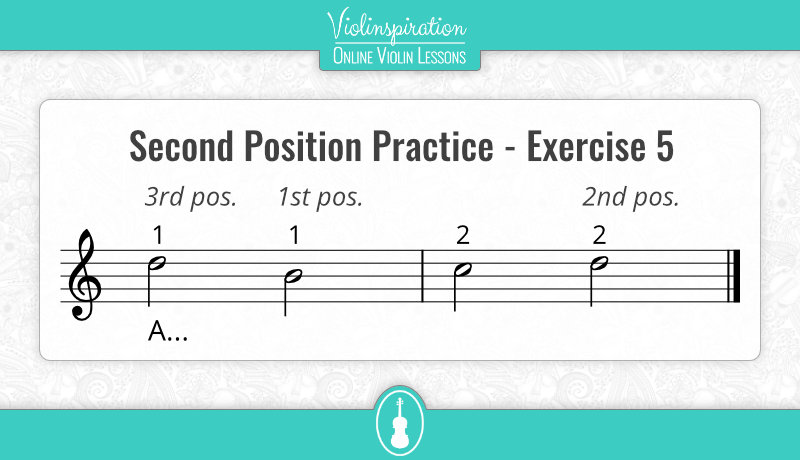
Try any combination of notes with these exercises – that will help you fully understand the position and the mechanics of shifting.
After doing the preliminary exercises, you should definitely try some scales and arpeggios.
Scales and Arpeggios
First, try the ones that are relatively easy while in the second position. These are: C, C#, Bb, B, F, and F#.
The easiest to start with are C, F, and Bb. You can play two-octave C and Bb Major scales and a one-octave F Major scale. Then, follow along by practicing C, B, and F# Minor scales. While working on the scales, add arpeggios and listen carefully to the tone of each note.
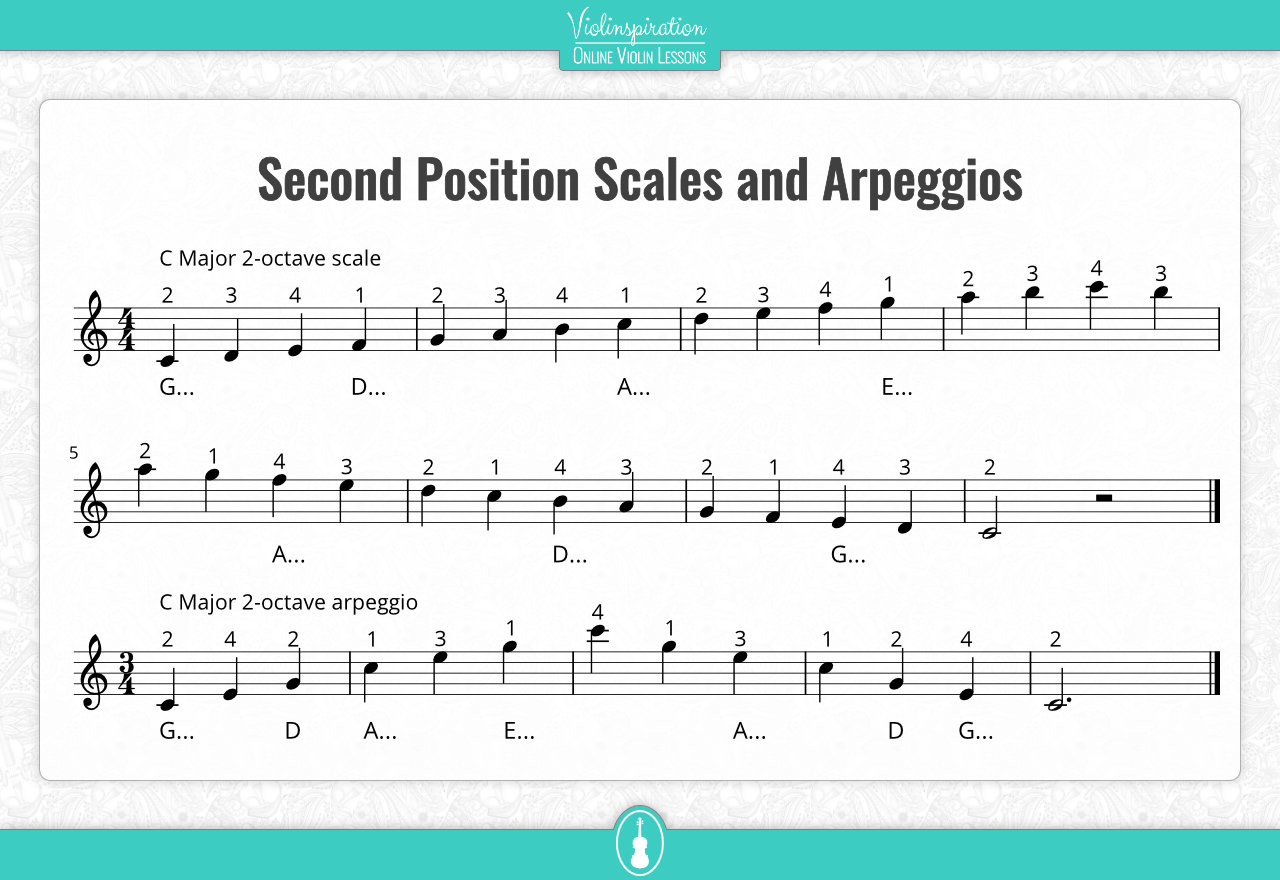
After that, some scale exercises will be perfect before trying any etudes.
Broken Thirds
Skip a note and then go back, then skip one again, etc. Let’s have a look at the F Major scale. Play F – A – G – B and continue like that up to F on the A string, then go back similarly.
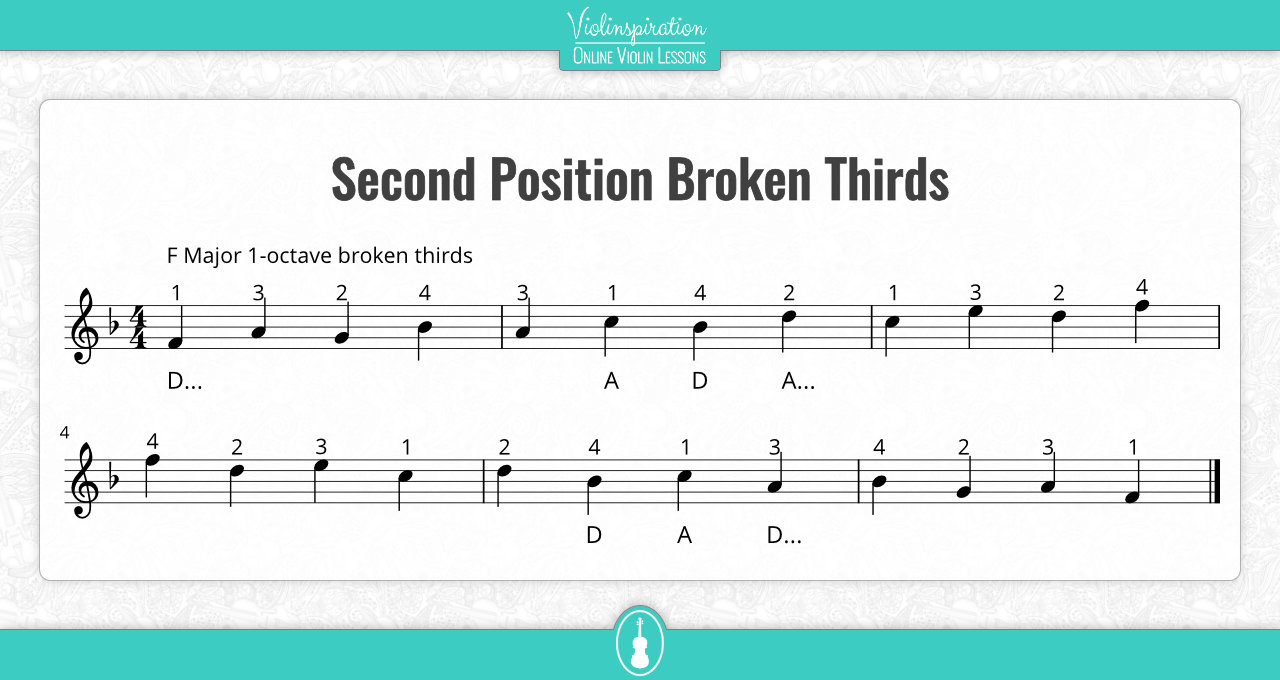
Bonus Exercise
In the same example, try now to go from F to B and then go back by playing A – G – F – G. Next, play from G to C and go back, playing B – A – G – A, then continue likewise.
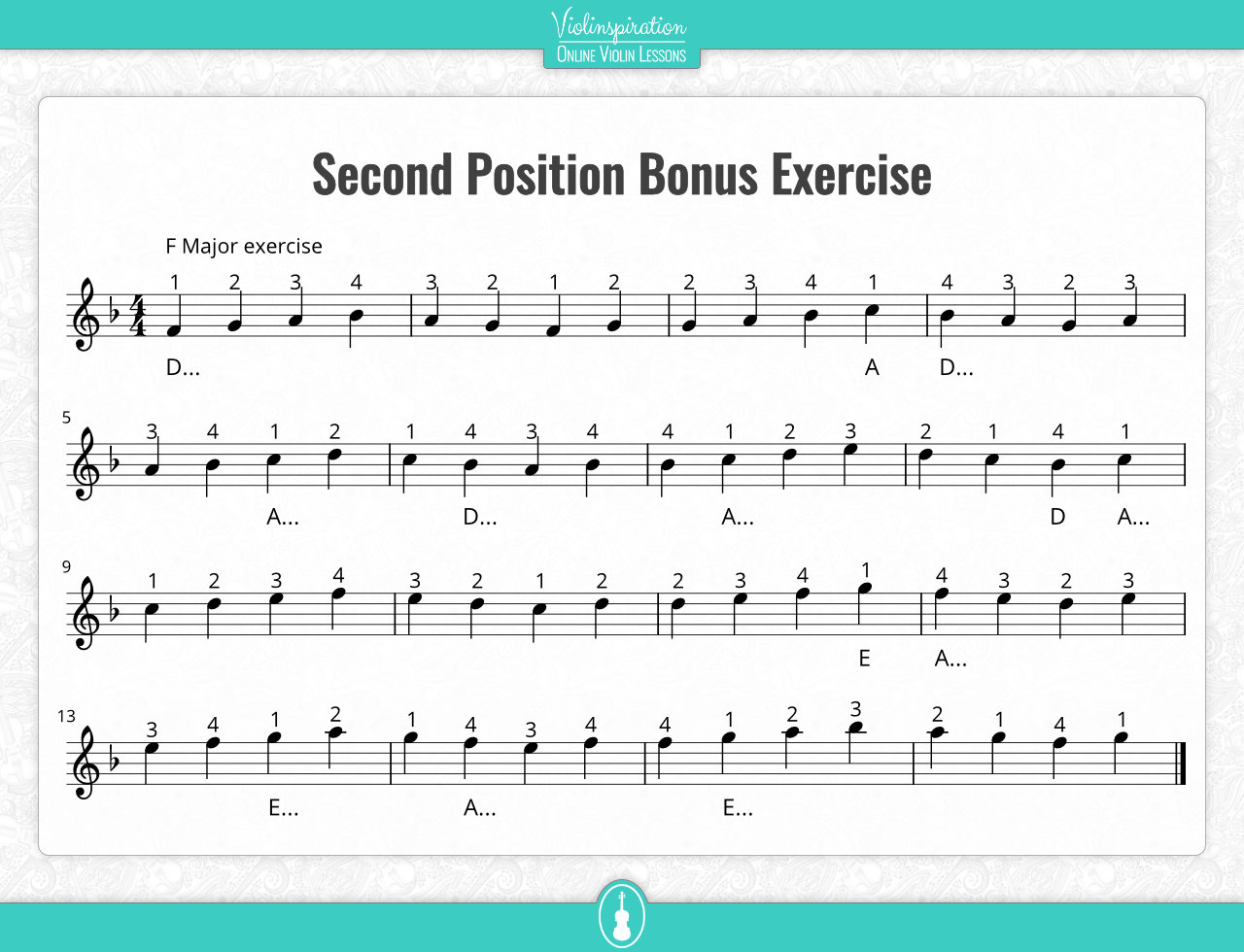
These scales and exercises are the perfect preparation before venturing into etudes and repertoire that requires playing in the second position. They are also very helpful as a warm-up.
You can download a free booklet with the easiest scales, arpeggios, and exercises here:
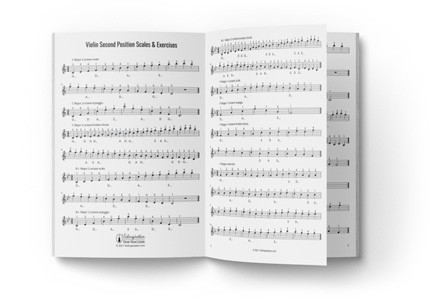
Violin Second Position
Scales and Exercises
Free Violin Sheet Music
Of course, you can play any scale in this and other positions, even for just one octave. So after doing the easy ones, you can challenge yourself and try all the rest of them, major and minor, including arpeggios and broken thirds.
What to Practice in the Second Position on the Violin
When violin etudes emerged, violinists were not using the second position extensively, so many teachers, even up to around the mid to early 20th century, used to pass it by quickly. This is of course not a rule, but many teachers will just explain how to play a passage in the second position when an etude or concerto requires it, giving more attention to the odd-numbered positions. While there are not as many books dedicated to the second position as there are for the third or fifth position, there are several that can help you!
Violin Studies for Practicing Second Position
The following resources will help you master the second position:
Jan Hřímalý – Scale-Studies for Violin
Yes, scales again, though this scale system is extremely useful for building technique as it has variations on scales while changing bowing techniques as well as positions. A very useful book for intermediate violinists!
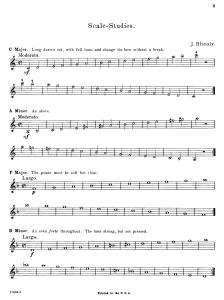
Scale-Studies for Violin by Jan Hřímalý
Free Violin Sheet Music
Henry Schradieck – School of Violin Technics
Schradieck is perfect for the left-hand technique. It has a dedicated chapter for the second position, as well as chapters combining positions.

School of Violin Techniques by Henry Schradieck
Free Violin Sheet Music
Otakar Ševčík
Ševčík is similar to Schradieck, though with much more detail. He has written a collection of books that cover virtually all violin techniques. The second position is mostly covered in Op. 1 Part 2, Op. 6, Op. 7, and Op. 8. Very challenging exercises, but they may be the best that you can find!
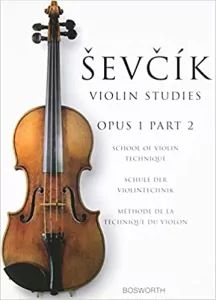
School of Violin Technique
Op. 1, part 2 by Otakar Ševčík
Free Violin Sheet Music
Carl Flesch – Das Skalensystem
Not a dedicated second position book, and this is for advanced students, but Flesch dedicates four pages for each scale, to train you in playing it while changing positions and other techniques. A good supplement to help you not only understand the positions but build a string technique.

Carl Flesch – Das Skalensystem
Free Violin Sheet Music
Rodolphe Kreutzer – Études ou caprices
In violin circles, this book is considered the bible of violin etudes. If you are interested in playing any of the well-known violin concertos, you will need this book, as it covers all techniques that appear in the classic repertoire. Kreutzer includes etudes that pass by the second position as well as some that make more extensive use of it.

Rodolphe Kreutzer – 40 Études ou caprices
Free Violin Sheet Music
Louis Spohr – Violinschule
Louis Spohr was a very important musician who is not as well known as he should be. He was a violinist, conductor, and composer who invented the chinrest, was one of the first to use a baton while conducting, and invented rehearsal letters. He is, however, most well known for this book, which has multiple etudes in the second and other positions.
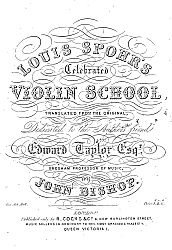
Louis Spohr – Violinschule
Free Violin Sheet Music
Violin Repertoire with use of the Second Position
And finally, a few pieces to play for you with the use of the second position:
Pierre Rode – 24 Caprices for Solo Violin, Op.22
Certainly not for beginners or maybe not even intermediate students, these are some amazing caprices that make use of the second and fourth positions in some of the most important etudes.
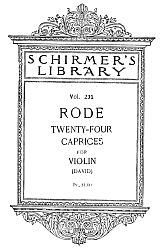
Pierre Rode – 24 Caprices for Solo Violin
Free Violin Sheet Music
Antonio Vivaldi – Violin Concerto in A minor
One of the first major concertos any violin student will play. This concerto can be played only using the first and third position – however, there are a couple of passages that can be played in the second position and can showcase its importance. E.g. in measure 7 where avoiding the fourth finger or open string for the E will feel more comfortable. The same is for measures 48–49 and 51, where the passage will flow seamlessly.
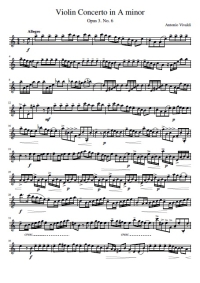
Antonio Vivaldi – Violin Concerto in A minor
Free Violin Sheet Music
Joseph-Hector Fiocco – Allegro
A well-known piece that is part of the sixth book of the Suzuki Repertoire and has been recorded by Itzak Perlman and others. It has been also arranged for strings and other ensembles, and can sometimes be heard at weddings. Its use of the second position is not extensive, but it can be used as a good introduction to the Bach concerto (see below) and the way which that makes use of the position.
Johann Sebastian Bach – Violin Concerto in A minor
Arguably one of the most well-known violin pieces, along with Vivaldi’s Concerto. This concerto makes extensive use of several positions and it is almost impossible to play without the second position. By applying everything you know about this new position, the concerto will be easier and you’ll be able to understand the usefulness of the second position.
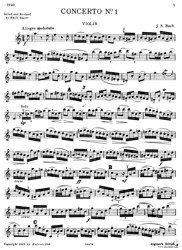
Violin Concerto in A minor by J.S. Bach
Free Violin Sheet Music
Final Note
Have you tried playing in the second position? Do you think it’s too challenging? I hope this article has cleared up how to play in the second position for you – whether you are new to the position or you have tried it and found it difficult. Remember that it’s totally understandable to get frustrated or disappointed at times, but everything can be solved with practice.
The second position is a powerful tool that will help you see a lot of passages in a new light. It can eliminate several changes of position or strings mid-passage.
Practice shifting and the preliminary exercises with patience. Then start practicing scales and scale studies. After that, you will be ready to get your hands on anything that includes the second position!
If you’re unsure whether you are playing correctly or are feeling no progress, remember you can always send your video and get feedback from a professional violin teacher and player – just click here (for members of Julia’s Violin Academy only).

Violin Second Position
Scales and Exercises
Free Violin Sheet Music
























